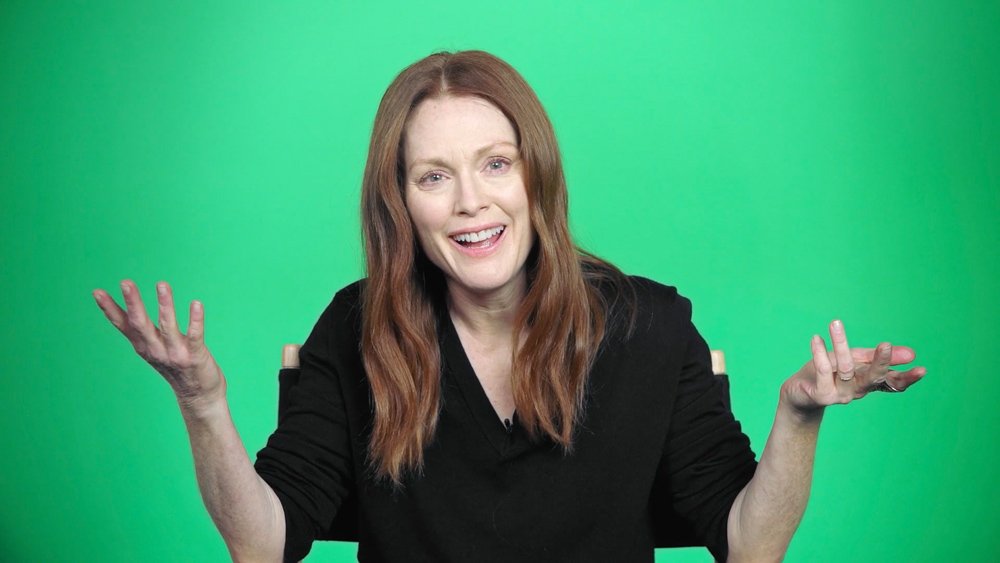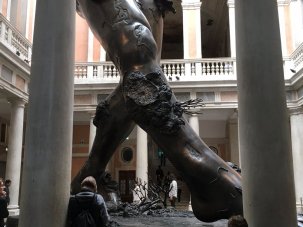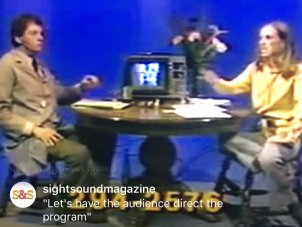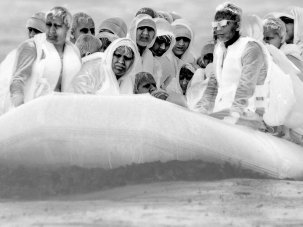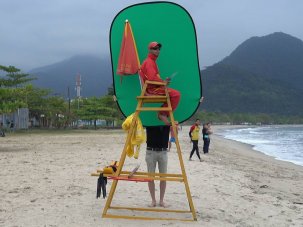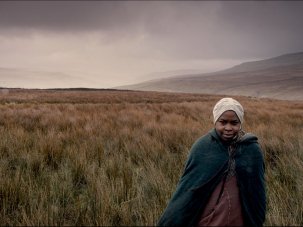In early May, before the Cannes Film Festival began, and set to last months beyond it, the Venice Biennale Arte launched its 57th edition. As a film distributor and producer who has worked with artists, I have developed an interest in that unsteady space where cinema and the visual arts meet. It was partly with this in mind that I crashed the press opening, but I was also drawn to the city of bridges for personal reasons – artists Geoffrey Farmer, Christian Marclay and Candice Breitz are all acquaintances, and I was keen to have a look at their pavilions.
The 2017 Biennale di Venezia, Italy, is running 13 May–26 November.
Berlin-based Breitz’s piece Love Story, in the South African Pavilion alongside Mohau Modisakeng’s Passage, stars Hollywood’s biggest names alongside refugees from some of the world’s more troubled countries. Conceived and shot by Breitz, and produced in part by art consultancy Parts & Labour, it features Julianne Moore and Alec Baldwin on one large screen, and in another room, videos of Syrian, Angolan, Congolese, Indian, Venezuelan and Somalian refugees, together creating a multi-channel, polyphonic narrative.
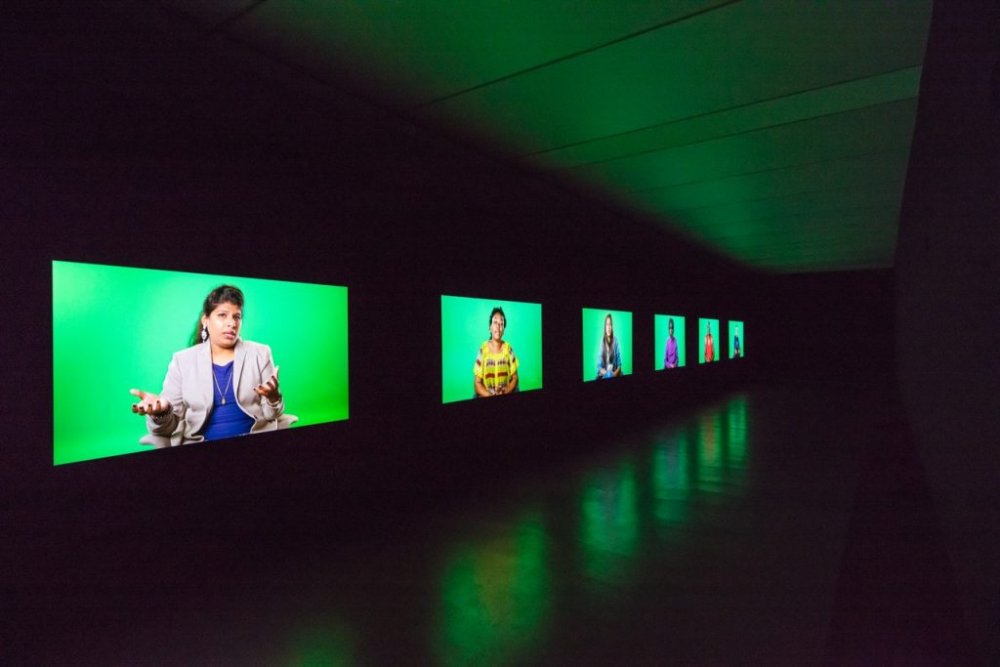
Candice Breitz’s Love Story
In the first room, you watch raw, unmade-up versions of Moore and Baldwin alternating speaking parts on two separate green screens. The next room features six more green screens, all playing simultaneously, with the audio delivered by headphones. Three women and three men all tell their individual, often harrowing, stories of war, torture and escape. Moore and Baldwin occupy the roles of each of the three men or women, retelling their stories, verbatim.
What struck me most was the chameleon-like nature of the actors’ performance while at the same time they felt very much being themselves – even when they were re-expressing the participants’ impressions of them in the third person. As a viewer watching the dialogues against the blank green-screen canvas, you feel the hardship from multiple perspectives in a physical, visceral way.
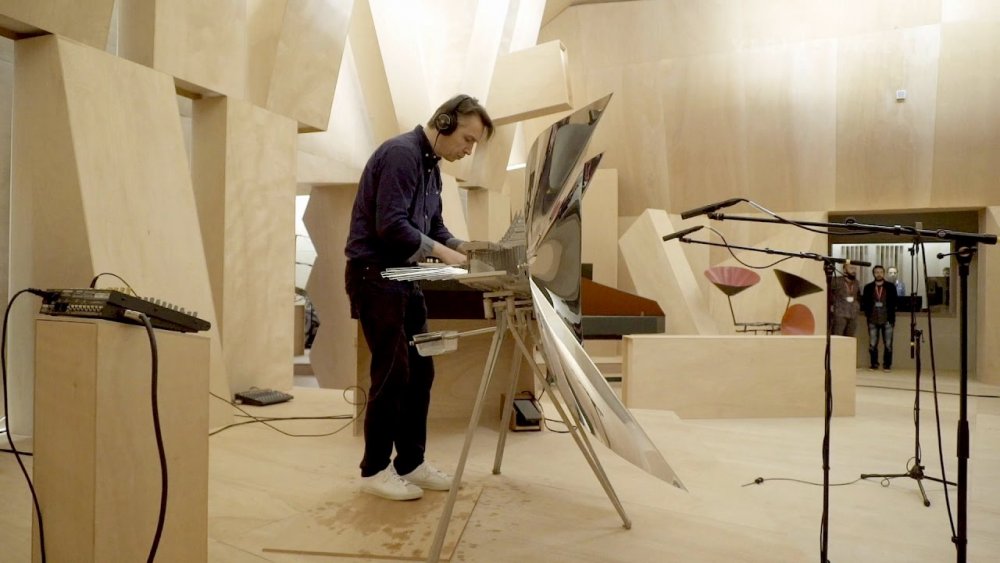
Xavier Veilhan’s Musical Merzbau
US-born artist and composer Marclay, who won the Golden Lion in 2011 for The Clock, makes an appearance not as an artist but a curator. Together with fellow Swiss Lionel Bovier, art critic, historian, publisher and director of MAMCO Geneva, he oversaw Xavier Veilhan’s transformation of the French Pavilion into a recording studio. Entitled Musical Merzbau (a reference to Kurt Schwitters’s house-sculpture, destroyed by a British bomb), visitors experience an array of instruments and song that will be recorded professionally throughout the six-month run of the Biennale.
The exterior of the building, which dates from 1912 and was designed by Venetian engineer Fauto Finzi, remains untouched, but the interior is utterly transformed, with plywood panelling, rockwool insulation and fabric for acoustics and atmosphere. When I walked in a man was on the piano and a young woman stood by his side singing an aria. It turned out that she was Farrah el Dibany and was performing Habanera from Georges Bizet’s Carmen (1875). The space becomes a kind of utopia only made possible by participation, interaction and activity. It feels like a cabin in the woods, with state-of-the-art sound and design and creative forces at work.
Geoffrey Farmer’s a way out of the mirror. Credit: Paul Allen – andfotography
Nearby, past Phyllida Barlow’s bulbous formations outside the British pavilion, Geoffrey Farmer tore the roof off the Canadian pavilion. Titled a way out of the mirror, after a line in Allen Ginsberg’s poem Laughing Gas, his piece not only completely deconstructs the building but moves the entrance to the back to create a clear view to the central piece: an unruly jet of water that shoots over 30 feet high. A grandfather clock (akin to the one in Chitty Chitty Bang Bang) plays a supporting role, slashed by an axe and other tools, and also squirts water, while a human-sized preying mantis (inspired by Germaine Richier’s La Mante, grande) poses with scissors in his back and a book on its lap.
Farmer was inspired by a 1955 press photograph found by his sister of a pickup truck slammed into a post at a railway crossing, its timber spilled across the ground in front of it. He remade these pieces of timber, all 71 of them, out of brass, and hollowed them out so that they could spray water throughout the pavilion in a seemingly haphazard way, evoking the randomness of accidents, and those unspoken traumas that alter the course of any family’s history. To walk around and through it reminded me of an outdoor cinema of moving sculptures, sounds and water. It feels serene and beautiful at first glance, then becomes austere and haunting and finally resolves itself in a cathartic climax – in this way it is has a three-act structure, much like most films.
Shimabuku’s The Snow Monkeys of Texas
Outside this trio, I did make one happy discovery (I could have made more with more time, but the show is vast and sprawling, with over 500 artists). Japanese artist Shimabuku had a wide-ranging installation in the Arsenale, including a video of him sharpening an Apple laptop to use to cut an actual apple. But his work that really grabbed my imagination was a fun and cogent 20-minute film, The Snow Monkeys of Texas, that asks the question “do snow monkeys remember snow monkeys?”
Shimabuku had found a story from 1972 about snow monkeys being taken from the mountains near Kyoto to the desert in Texas. Faced with unfamiliar and barren terrain, only cacti to eat and rattlesnakes to battle, unsurprisingly most of them died within a year. Against the odds, a few managed to survive and reproduce as the next generation taught themselves how to survive, revealing that monkeys are more potentially more resourceful than their cleverer cousins.
In 2016, Shimabuku visited them and thought they looked bigger and “Americanised”, so he decided to take a small mountain of snow to them to see if they would respond to it, as if their genetic code might magically conjure some lost but unbreakable relationship. The monkeys putter around the snow, curious, nibbling, looking around, but that’s about it. Seems they had completely acclimatised to their new environment, from samurai to cowboy. Today’s beastly politicians could learn a lot from these monkeys.
Postscript: Khadija Saye R.I.P.
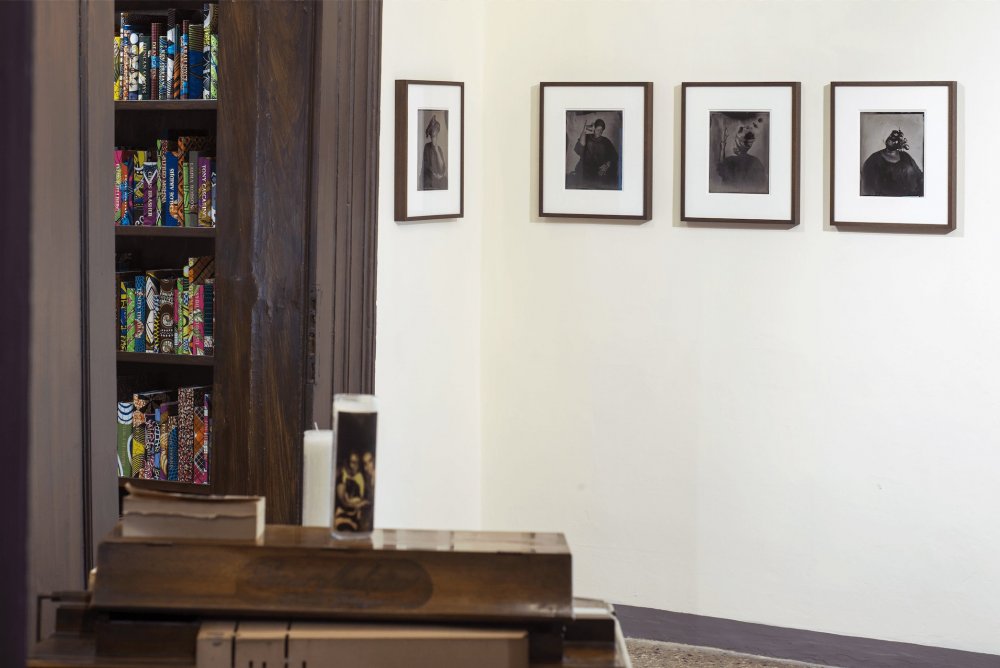
Saye’s Dwelling: in this space we breathe (2017) at the Venice Biennale’s UK Diaspora Pavillion
I also attended the opening of the UK’s Diaspora Pavilion at the Palazzo Pisani. Attendees entered through a glittering, golden curtain – Susan Pui San Lok’s Untitled (Pavillion) – that separated the outside from the inside in a disorientating, almost euphoric, way. Inside, the main attractions were Yinka Shonibare’s The British Library, a collection of Dutch Batik wax-bound books from the Western canon highlighting immigrants who contributed to British life and culture; and Isaac Julien’s new single-screen version of his three-screen 2007 Sicilian video essay Western Union: small boats, subverting Visconti’s The Leopard in collage form.
But so many others added to the diverse programme, including a series of tintype photographs, Dwelling: in this space we breathe, by Khadija Saye, who despite being the youngest person to exhibit in the collective showed great maturity and vision in her work. The curatorial notes commented on her use of photography to explore nostalgia, memory and tradition while she added that they represented her personal need for spiritual grounding after experiencing trauma… and that “each [piece] has its own unique story to tell.”
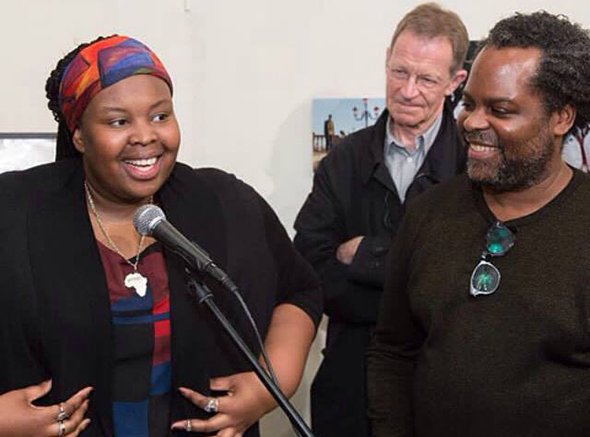
Saye with Nicholas Serota and David A. Bailey at the opening of the Diaspora Pavillion
I met her through my husband Craig Burnett who worked with her as a trustee at PEER gallery, where she started out as a Creative Access intern in 2015. She beamed with pride and excitement about being part of it all – a moment of beauty. A month later, she sadly died with her mother in the Grenfell Tower fire. One of her pieces from this exhibition can now be seen at Tate Britain – and her legacy will endure. As she all too poignantly said, “We forget to live through the moment, remaining in the silence, and working on our internal connections.”
-
The Digital Edition and Archive quick link
Log in here to your digital edition and archive subscription, take a look at the packages on offer and buy a subscription.




